Metabolism of Light: How Coherence Reprograms Energy Utilisation in the Human Body
Abstract
Stable field coherence—a sustained, non-fluctuating state of awareness in resonance with its environment—has measurable impacts on human metabolism. This paper explores how coherent awareness shifts fuel utilisation, improves mitochondrial efficiency, reduces oxidative cost, and expands the body’s capacity to draw on subtle energetic inputs, such as breath-pattern resonance, biophotonic exchange, and structured water charge storage. We review relevant biochemical and physiological literature, propose mechanisms of action, and present field-derived case observations. Findings suggest that metabolic efficiency is not solely dependent on dietary or exercise interventions but can be profoundly influenced by the tone of awareness maintained within the system.
1. Introduction: Energy as Relationship
In the dominant biomedical model, metabolism is conceptualised as a closed system of chemical reactions driven by substrate availability, hormonal signalling, and physical activity. While accurate in its mechanics, this model overlooks the role of the autonomic and perceptual state in shaping metabolic behaviour.
Energy metabolism is not simply the sum of biochemical reactions—it is a relational state between the organism and its environment. This relationship is mediated by nervous system tone, endocrine rhythms, and cellular-level communication networks (including fascia, structured water, and bioelectromagnetic fields).
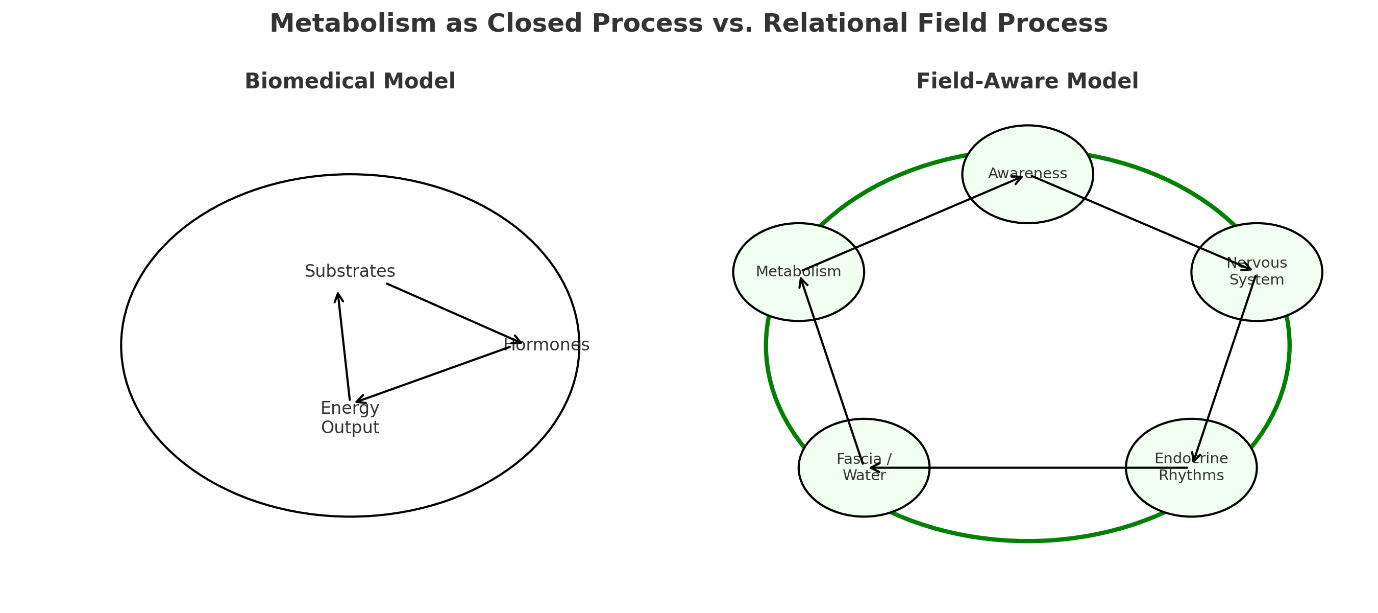
Metabolism as closed biochemical process (left) vs. relational field process (right).
When the field of awareness is incoherent, this relationship is unstable:
- The system is dominated by threat prediction.
- Energy acquisition becomes urgent and defensive.
- Storage and expenditure are driven by survival patterns, not adaptive optimisation.
In contrast, when awareness stabilises into field coherence:
- Threat signalling subsides.
- Energy acquisition and expenditure are tuned to actual need.
- Cellular communication and repair processes optimise.
- Efficiency increases without scarcity.
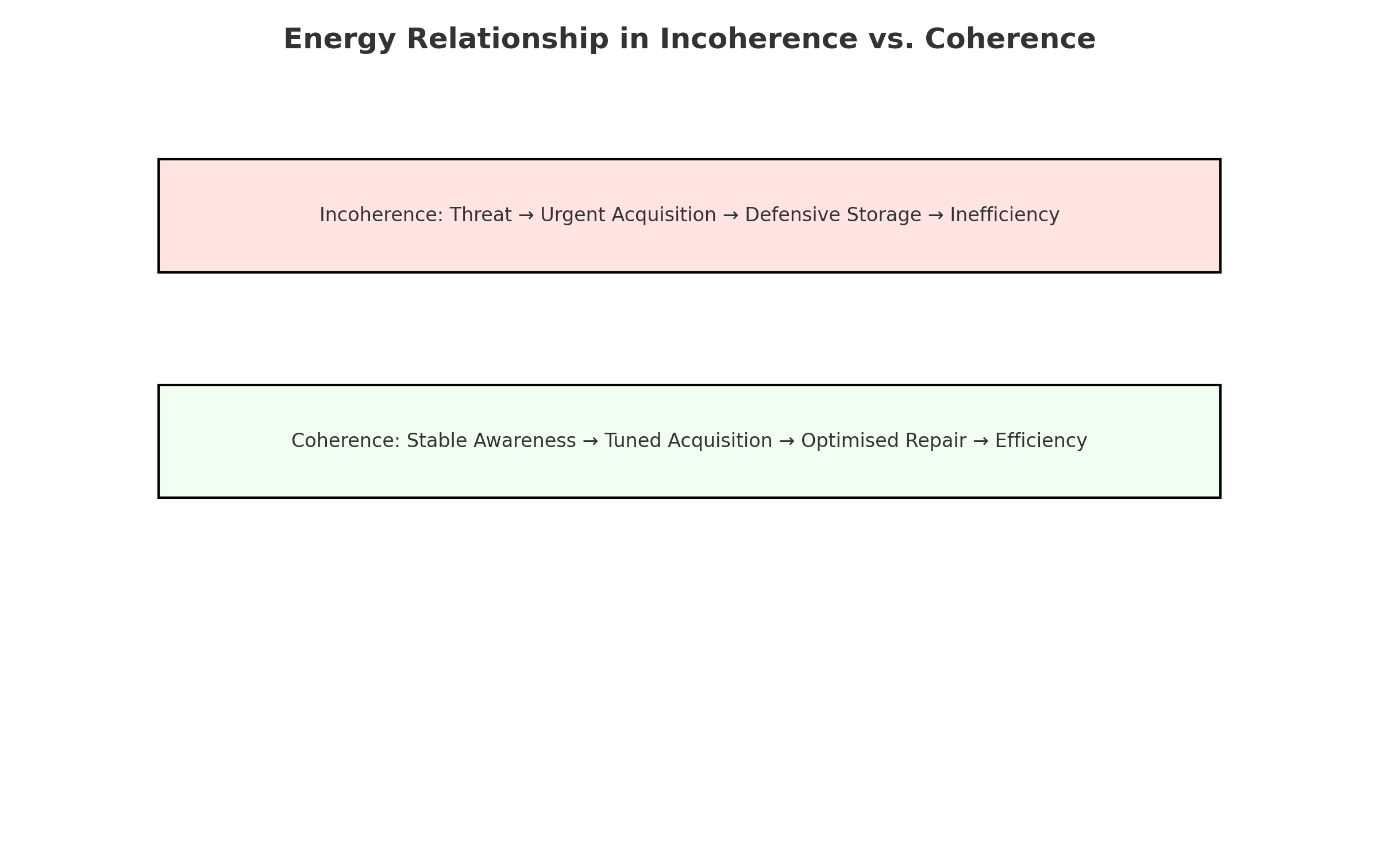
Awareness state shapes energy economy: incoherence drives inefficiency; coherence allows optimisation.
2. Energy in Incoherence: The Cost of Threat Signalling
The stress–metabolism loop in incoherence:
- Threat perception (often subconscious) → sustained sympathetic activation.
- Cortisol and catecholamine dominance → glycogen breakdown and gluconeogenesis → increased glucose dependency.
- Insulin cycling → frequent spikes and troughs in blood glucose → volatile energy availability.
- Mitochondrial inefficiency → higher reactive oxygen species (ROS) load and lower ATP per oxygen molecule (P/O ratio).
- Chronic low-grade inflammation → diversion of resources from growth and repair to immune defence.
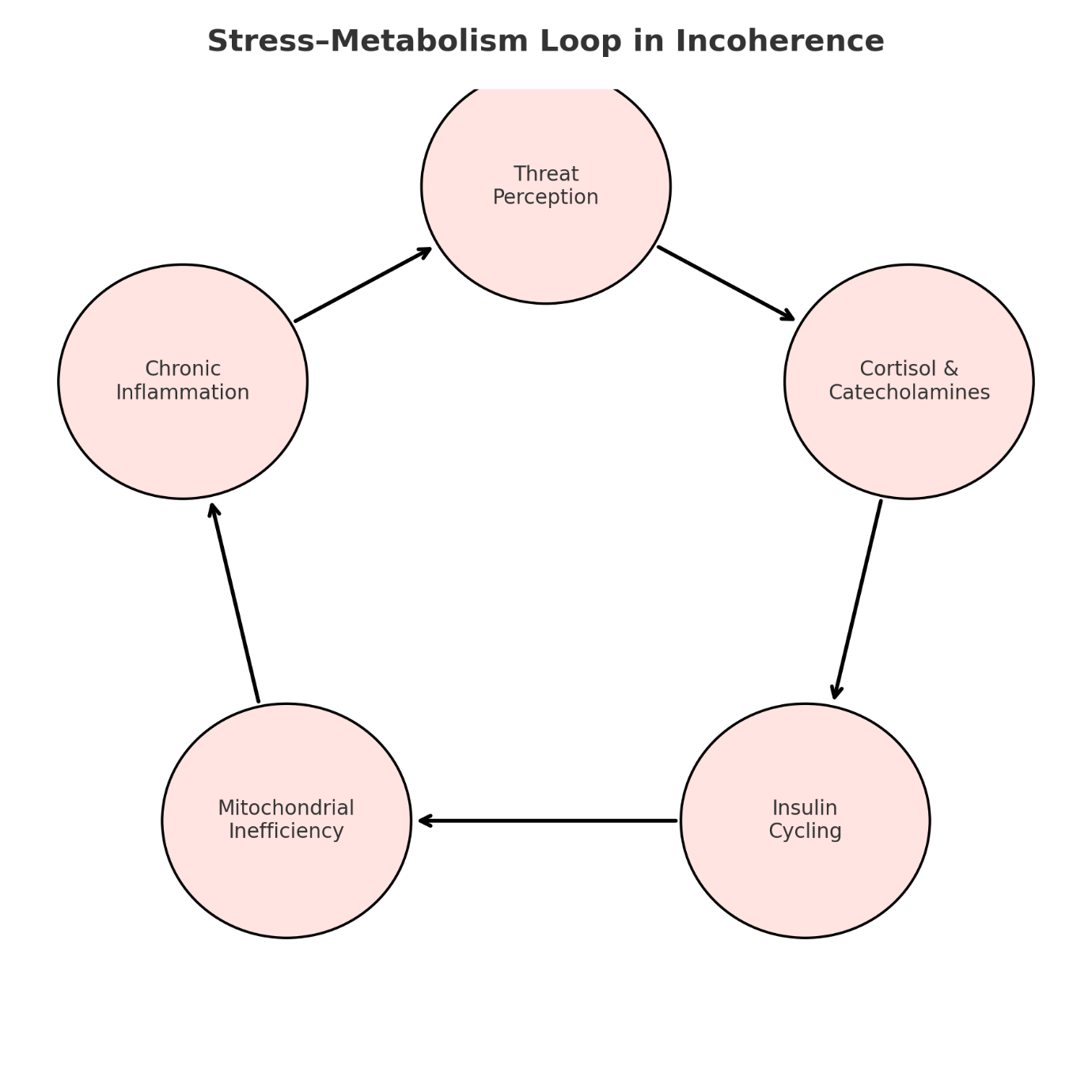
In incoherence, stress signalling drives a self-reinforcing metabolic loop, increasing systemic wear and energy inefficiency.
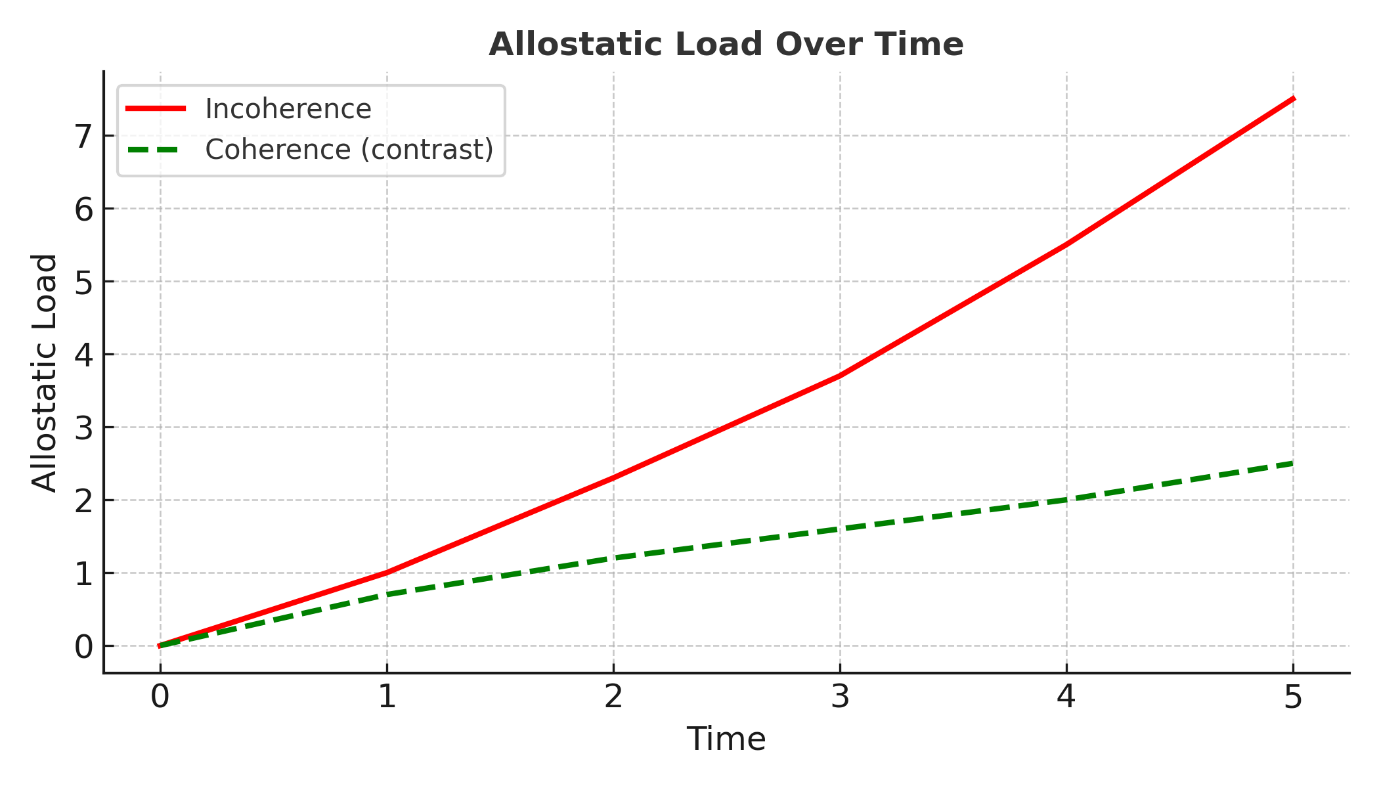
Incoherence accelerates allostatic load, wearing down metabolic resilience over time.
This pattern increases allostatic load—the cumulative biological wear from constant state adjustment—and accelerates metabolic aging.
3. Energy in Coherence: Efficiency Without Scarcity
Stable awareness interrupts this loop.
Physiological correlates include:
- Lower basal cortisol and catecholamine levels → reduced reliance on rapid glucose mobilisation.
- Increased fat oxidation and ketone utilisation → improved metabolic flexibility.
- Improved mitochondrial P/O ratio (ATP yield per O₂ molecule).
- Reduced ROS production → less oxidative damage and lower need for antioxidant defence.
- Upregulated repair pathways (autophagy, mitochondrial biogenesis) even in non-fasting states.
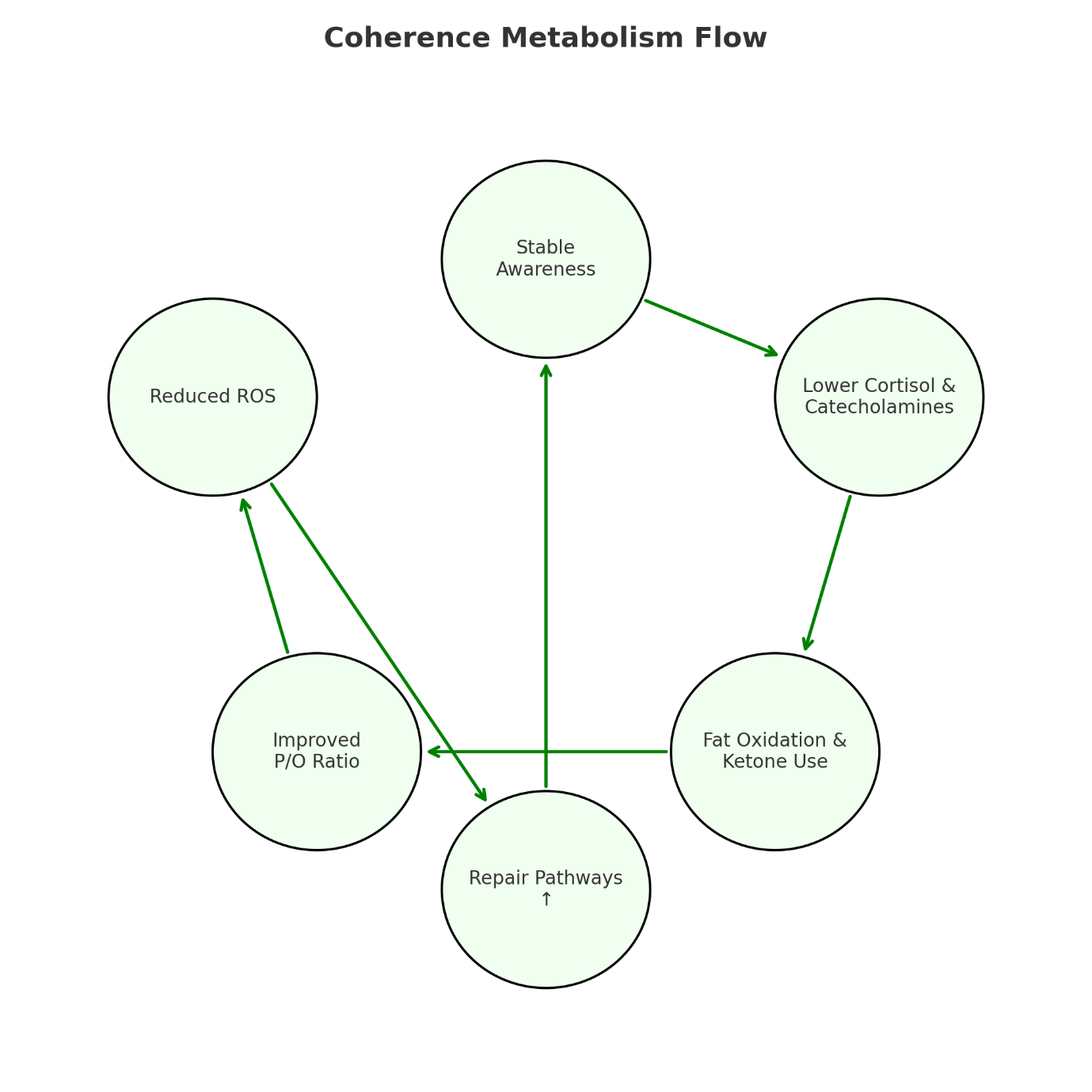
In coherence, awareness stabilises a positive feedback loop of efficiency and repair.
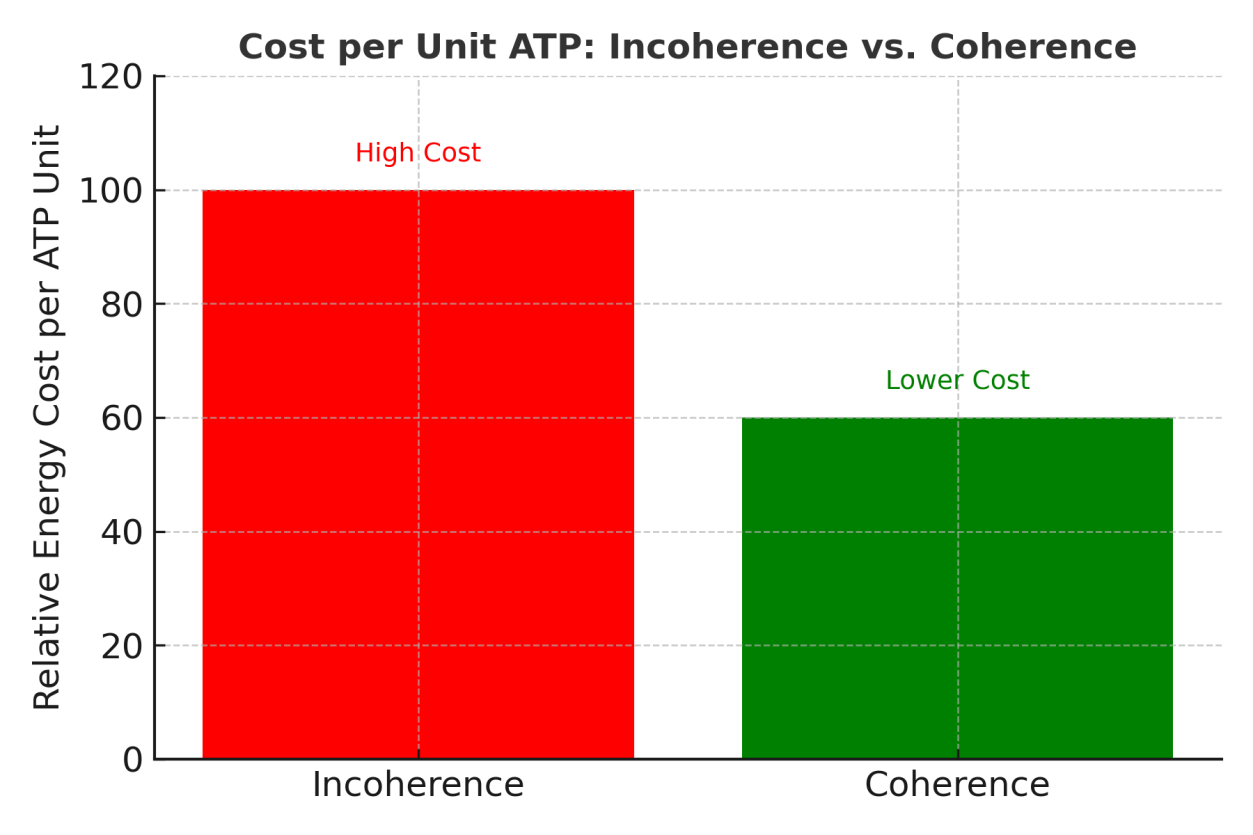
Coherence lowers the energy cost per unit ATP, improving efficiency without scarcity.
These shifts reduce the body’s perceived need for constant refuelling and lower the cost of each unit of ATP produced.
4. Breath, Light, and Silence as Fuel Inputs
4.1 Breath Coherence
- Mechanism: Coherent, diaphragmatic breathing optimises the O₂–CO₂ balance, improving oxygen unloading via the Bohr effect.
- Outcome: Increased endurance and reduced perceived exertion without changes in cardiovascular fitness.
- Field observation: HRV increases, respiration slows, and CO₂ tolerance rises in coherent individuals.
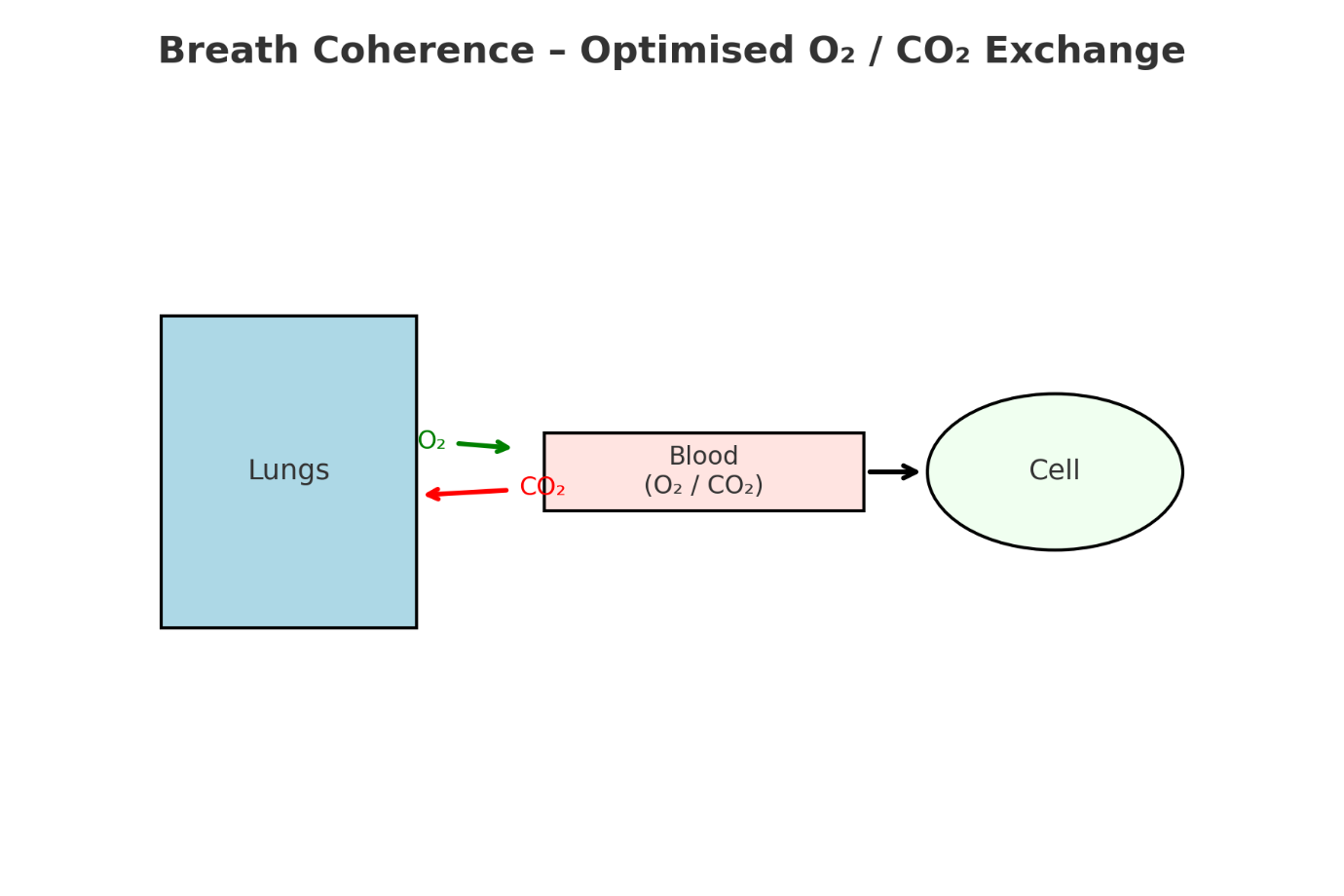
Coherent breathing optimises oxygen exchange and raises CO₂ tolerance, enhancing endurance.
4.2 Light (Biophotonic Exchange)
- Mechanism: Mitochondria and other cellular structures emit and absorb ultra-weak photons. Coherence appears to synchronise emission patterns, improving signal fidelity across tissues.
- Outcome: Enhanced metabolic regulation via redox balance and mitochondrial network synchronisation.
- Evidence: Studies by Fritz-Albert Popp suggest coherent biophoton emission in healthy systems vs. chaotic emission in diseased states.
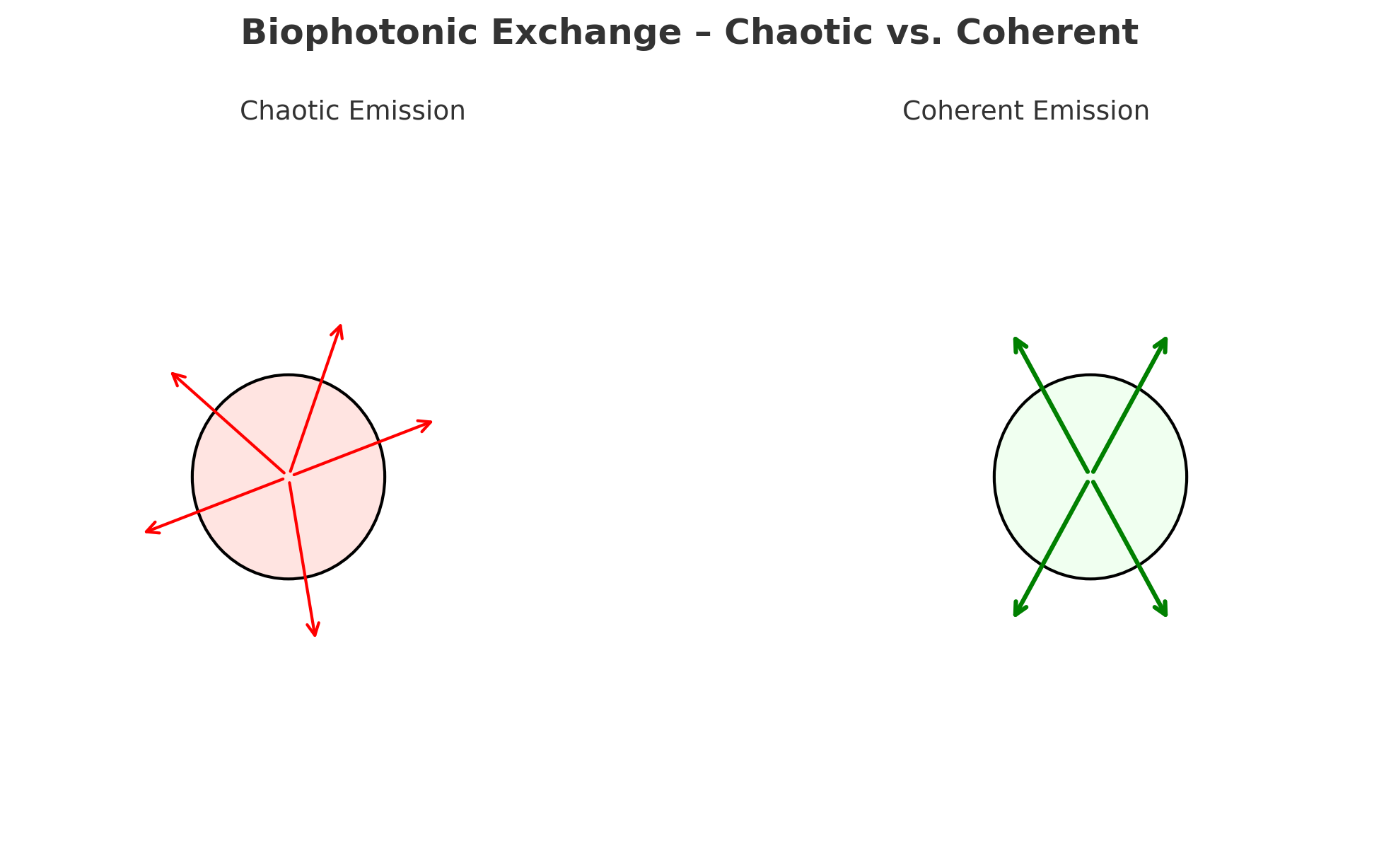
In coherence, cellular photon emissions synchronise, improving redox regulation and metabolic signalling.
4.3 Silence (Field Stillness)
- Mechanism: In a coherent state, cortical and subcortical activity reduce unnecessary predictive processing.
- Outcome: Brain’s metabolic draw decreases, freeing glucose and oxygen for regeneration, immune function, and creative insight.
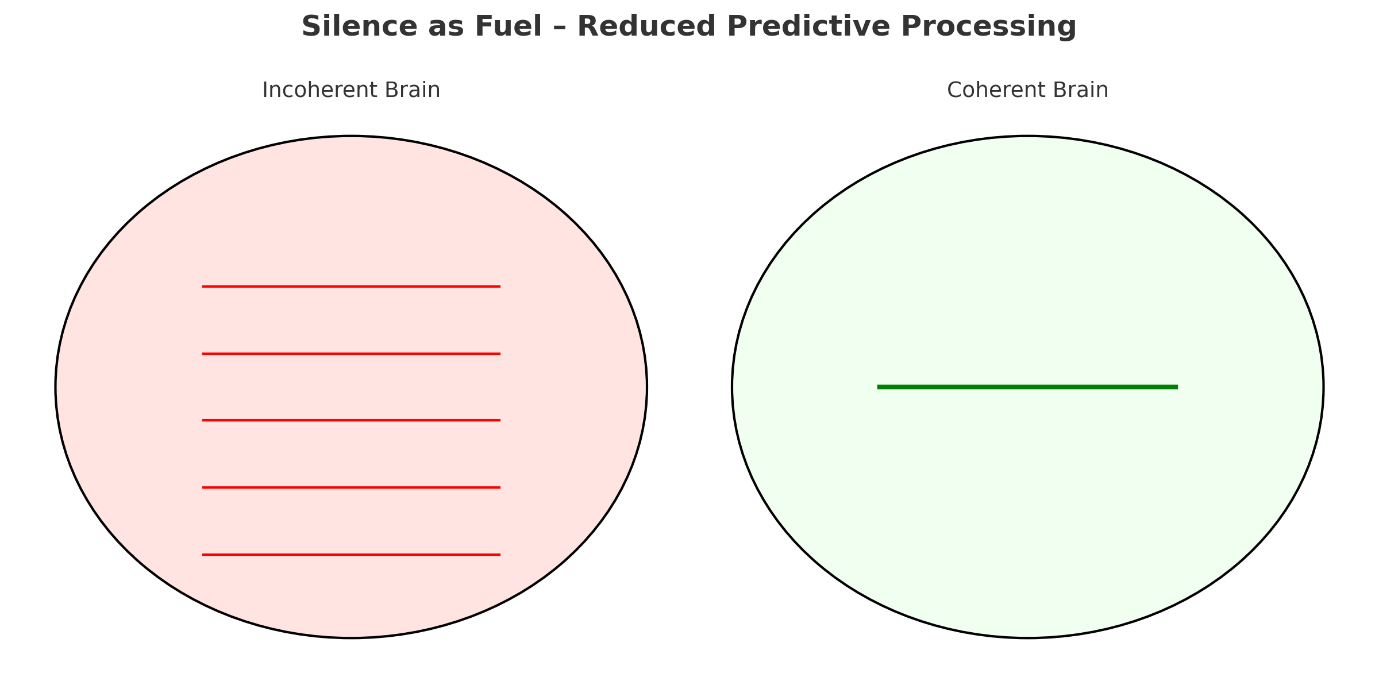
Silence reduces predictive processing load, lowering brain’s metabolic demand.
5. Structured Water and the Energy Economy
Structured (Exclusion Zone, EZ) water:
- Forms at hydrophilic surfaces (e.g., cell membranes, fascia).
- Stores electrical potential (negative charge).
- Expands under infrared light and mechanical flow.
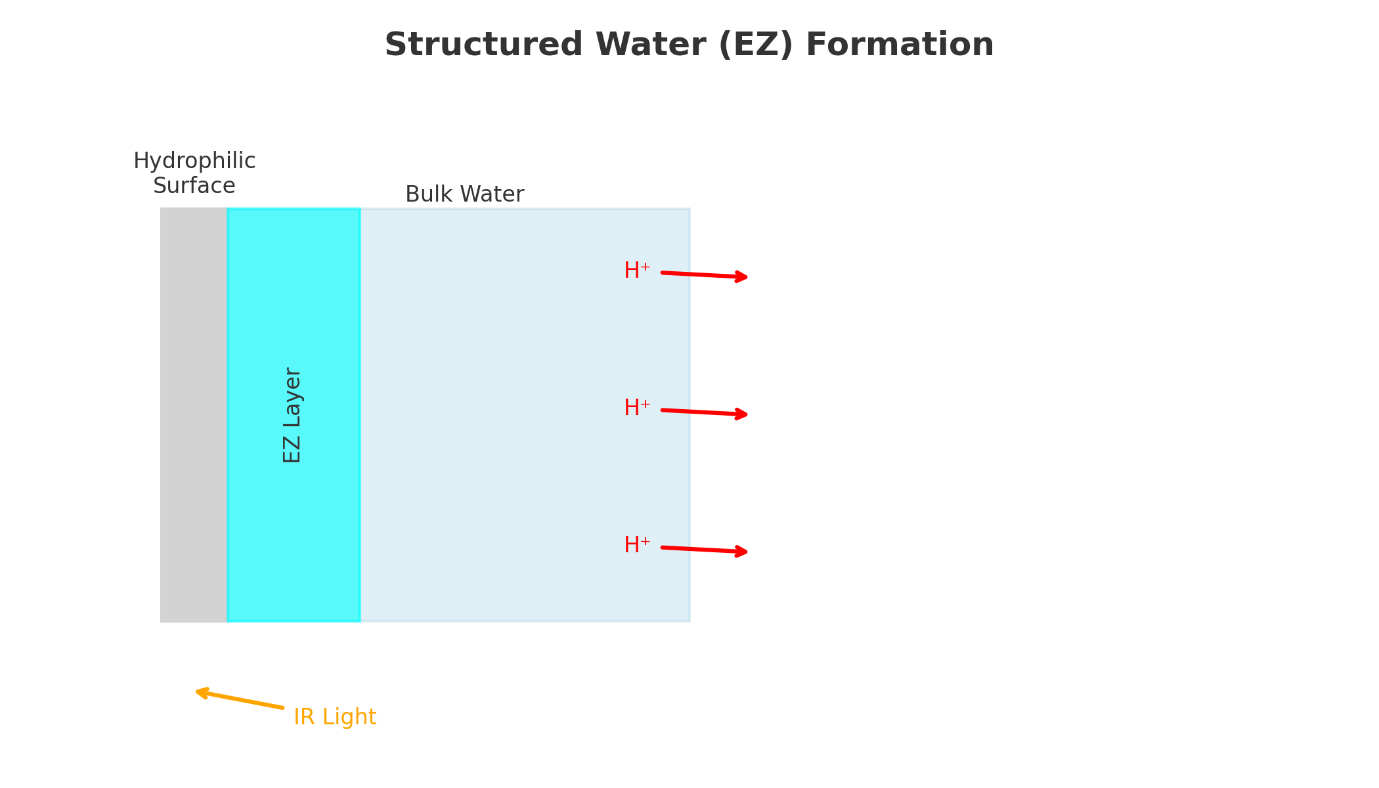
EZ water forms at hydrophilic surfaces, stores charge, and expands with light.
In coherence:
- EZ layers thicken, improving ionic gradients and reducing metabolic pumping costs.
- Mechanical and electromagnetic inputs (movement, sound, light) are transduced more effectively into usable biological energy.
- This creates a subtle energy credit—reducing reliance on macronutrient oxidation for immediate energy needs.
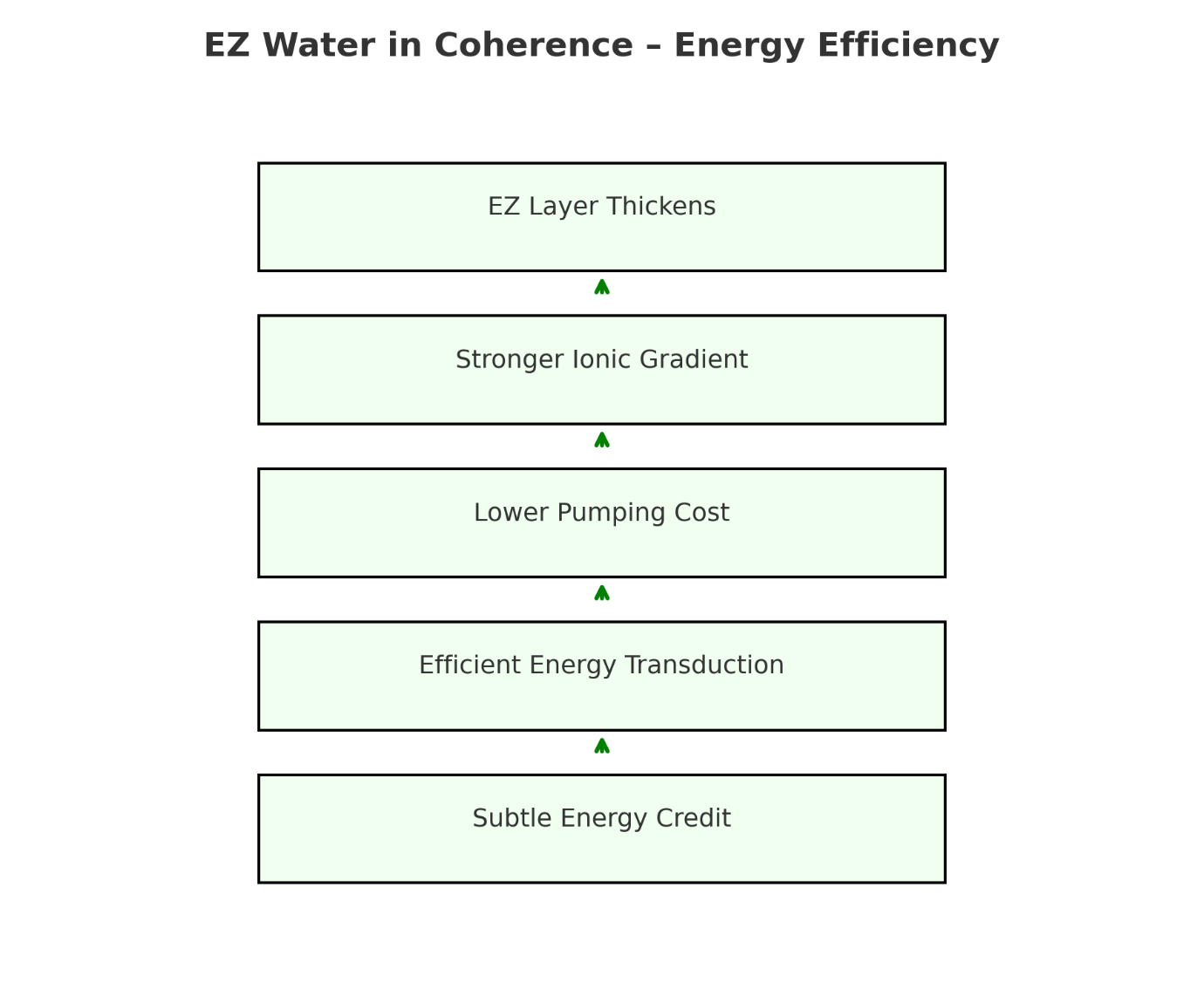
In coherence, EZ water thickens and improves energy efficiency, reducing metabolic dependence on macronutrient oxidation.
6. Case Patterns from the Field
Case 1 – Reduced caloric intake without loss of performance:
Coherent individuals often spontaneously reduce food volume while maintaining or improving energy output, suggesting improved nutrient absorption and metabolic efficiency.
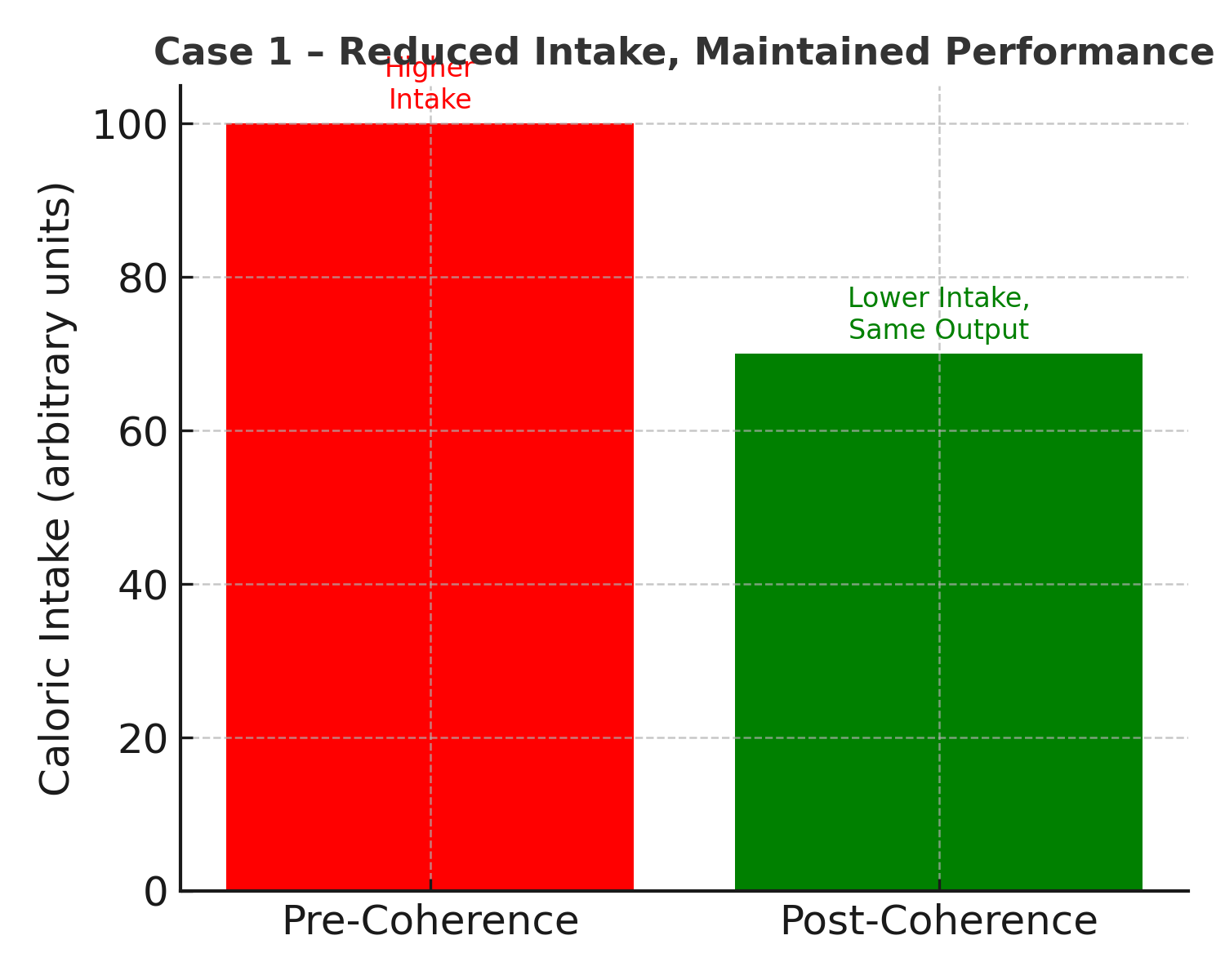
In coherence, energy efficiency rises, allowing reduced intake without performance loss.
Case 2 – Normalised weight without targeted intervention:
Both underweight and overweight individuals have shifted toward stable, healthy mass ranges without diet manipulation.
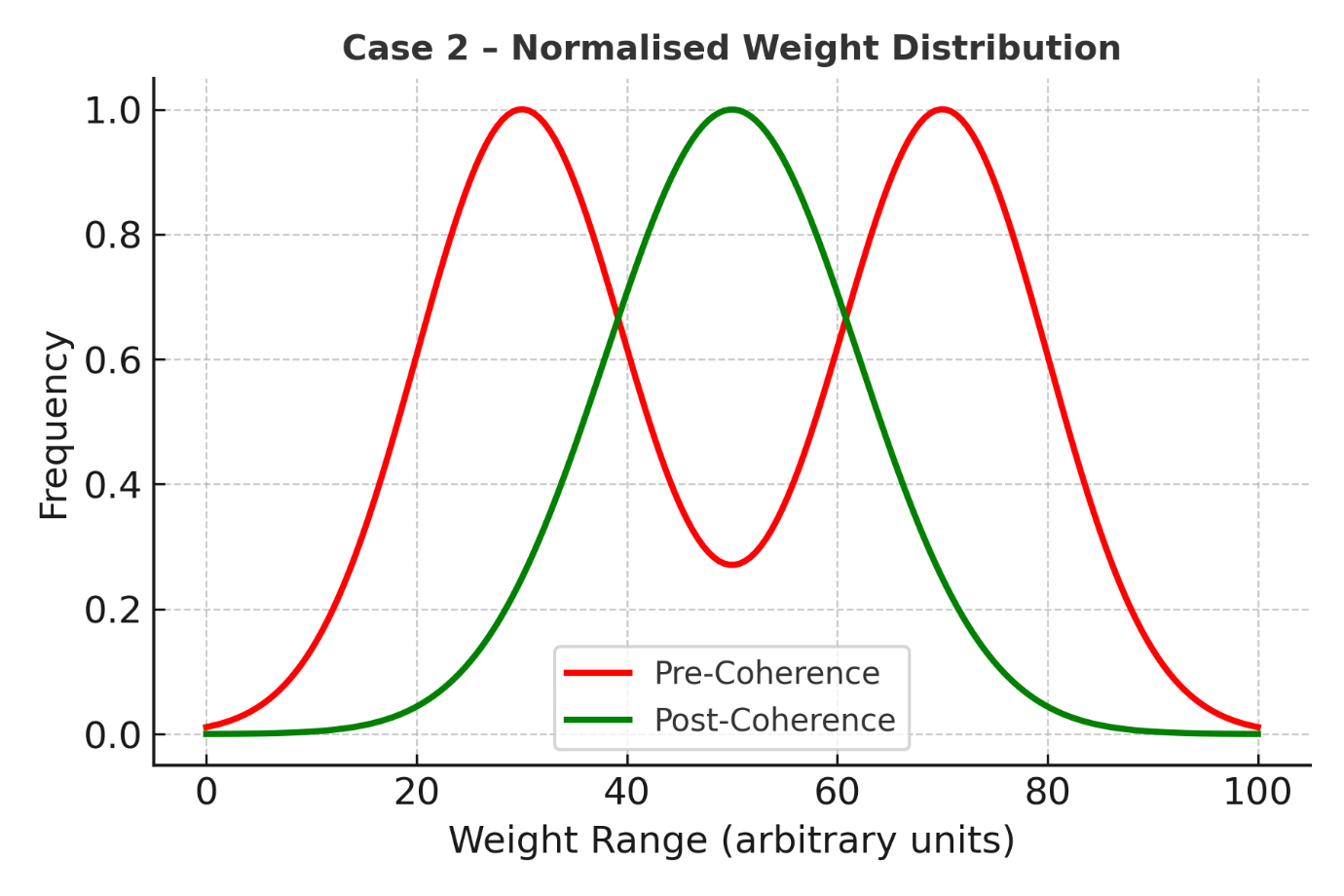
Coherence stabilises body weight without targeted interventions.
Case 3 – Increased endurance with less perceived effort:
Athletes in coherent states report sustaining activity longer with lower heart rates and less fatigue.
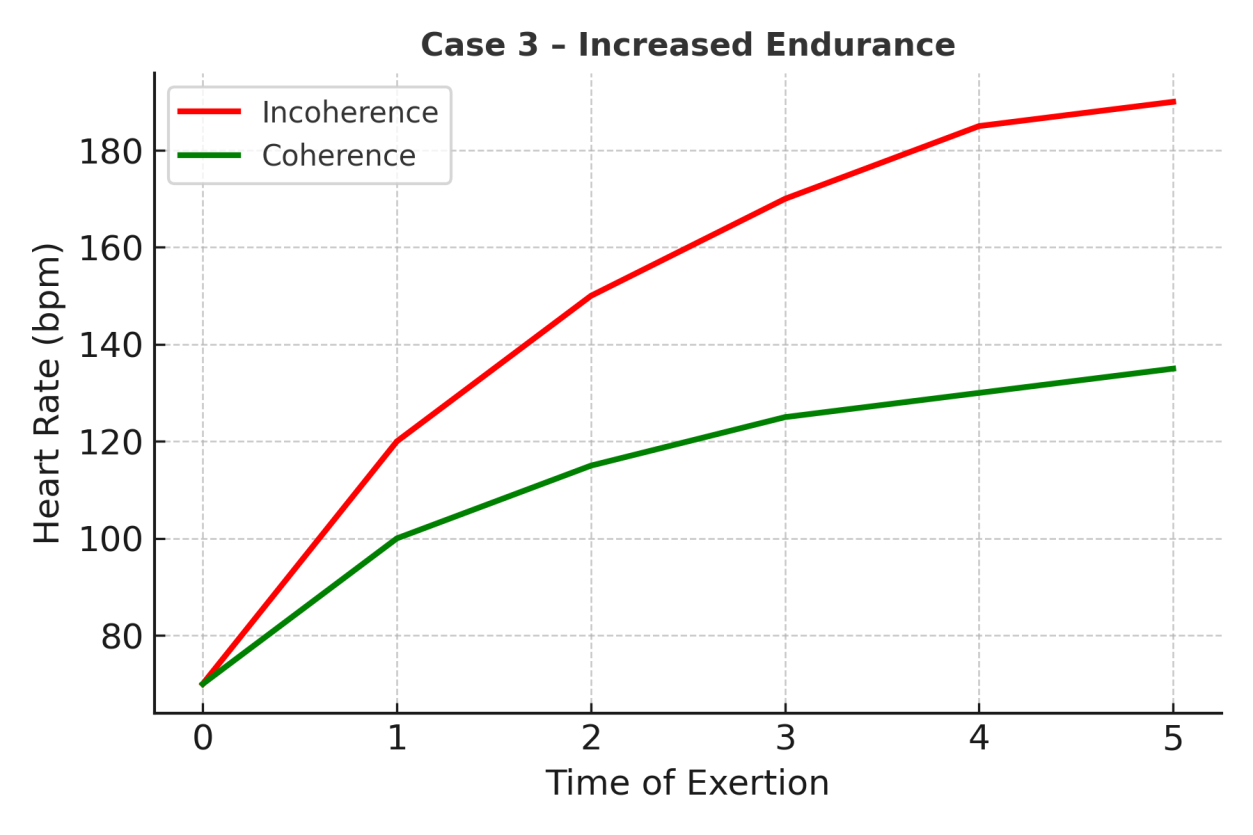
Athletes in coherence sustain performance longer with lower physiological cost.
Case 4 – Improved thermoregulation:
Peripheral warmth improves in coherent states due to optimised vascular tone and reduced sympathetic overdrive.
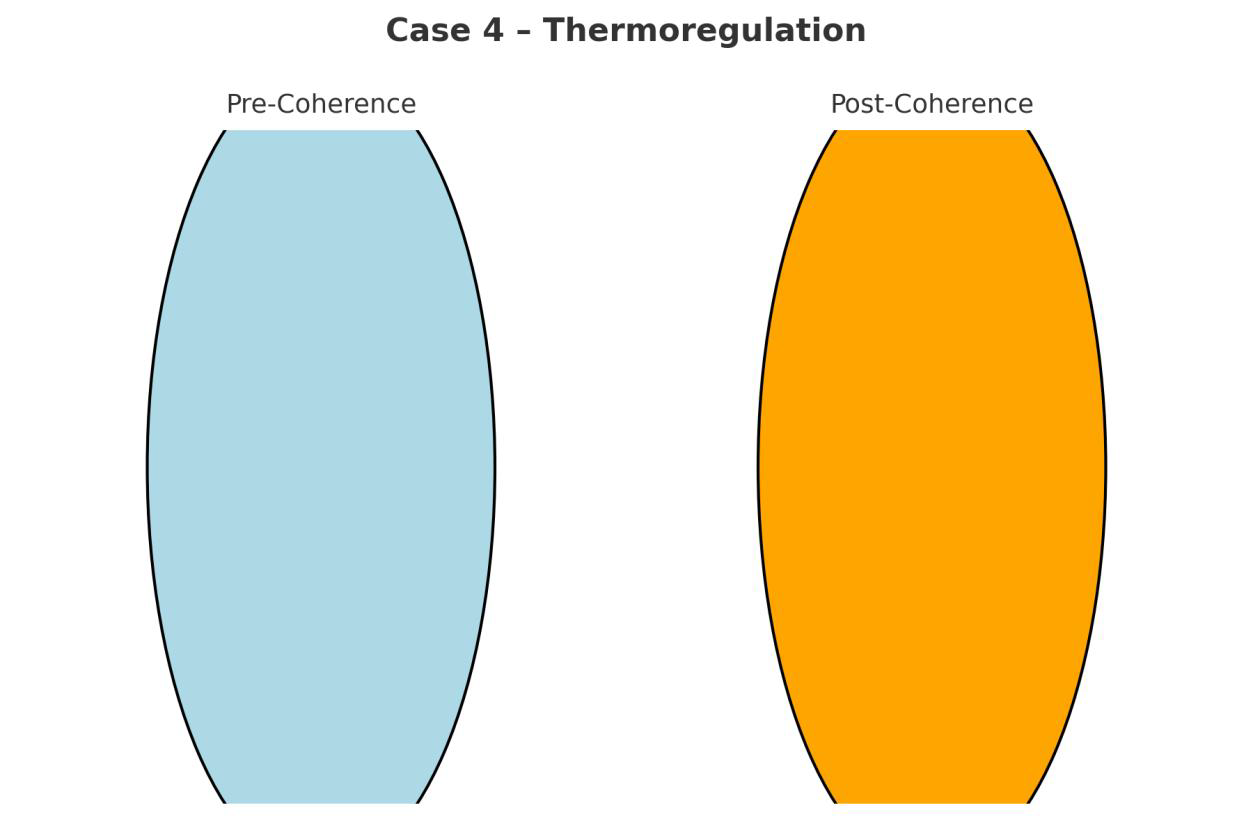
Peripheral warmth improves in coherence due to optimised vascular tone.
7. Mechanistic Hypothesis: The Coherence Metabolism Loop 1. Stable awareness → reduced threat signalling. 2. Reduced threat → lower allostatic demand on metabolic systems. 3. Lower demand → higher mitochondrial efficiency. 4. Higher efficiency → greater metabolic flexibility. 5. Flexibility → access to subtle energy inputs (breath, light, structured water). 6. Subtle inputs further stabilise coherence → loop reinforces itself.
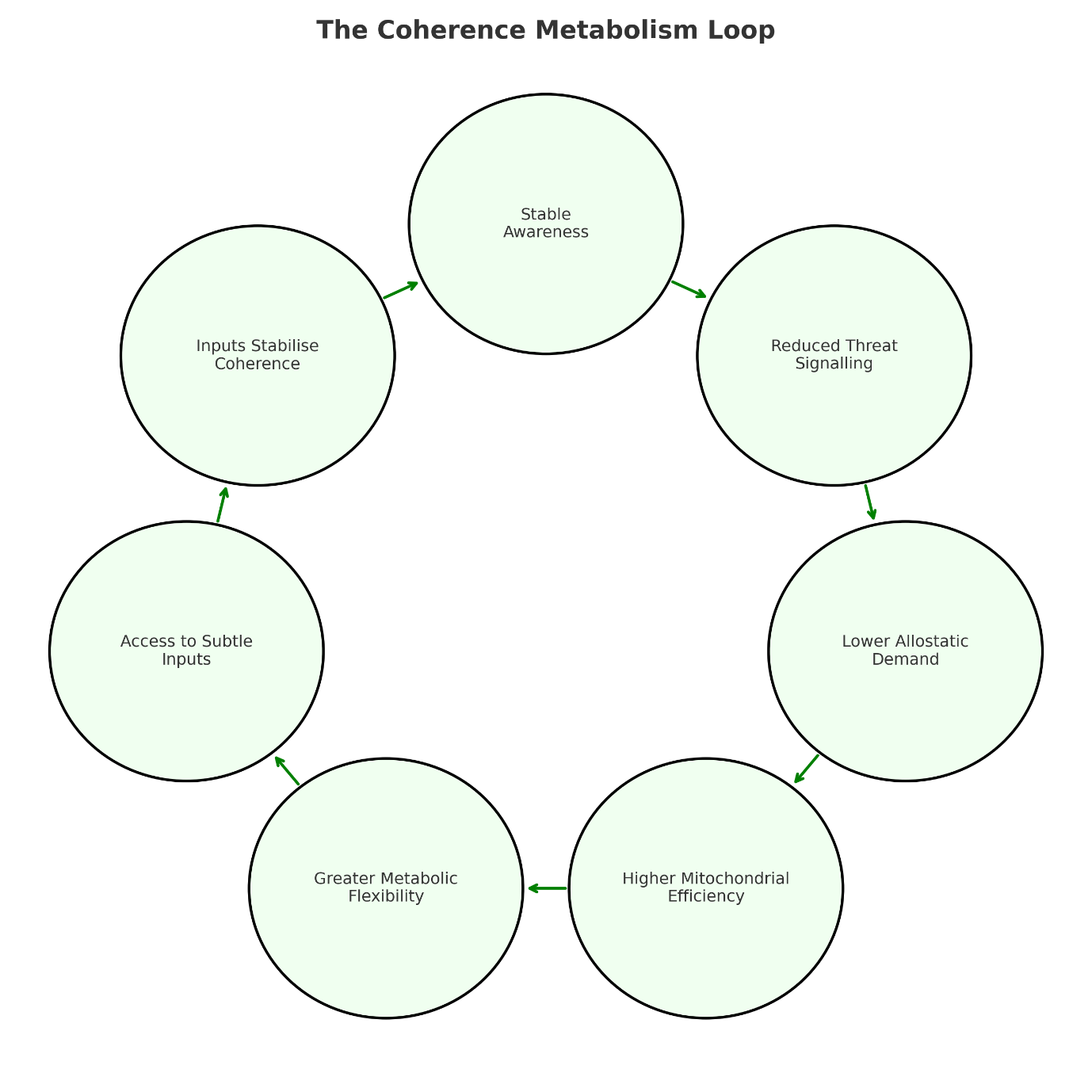
Coherence forms a regenerative feedback loop: awareness reduces systemic cost, which expands flexibility and subtle energy access, which in turn stabilises awareness.
8. Implications
Medicine:
Potential adjunct approach for metabolic syndrome, type 2 diabetes, and chronic fatigue by lowering allostatic load rather than relying solely on dietary or pharmacological intervention.
Performance:
Coherence-based metabolic conditioning may enhance endurance, recovery, and injury resistance.
Longevity:
Lower oxidative stress and improved repair mechanisms suggest a possible slowing of biological aging.
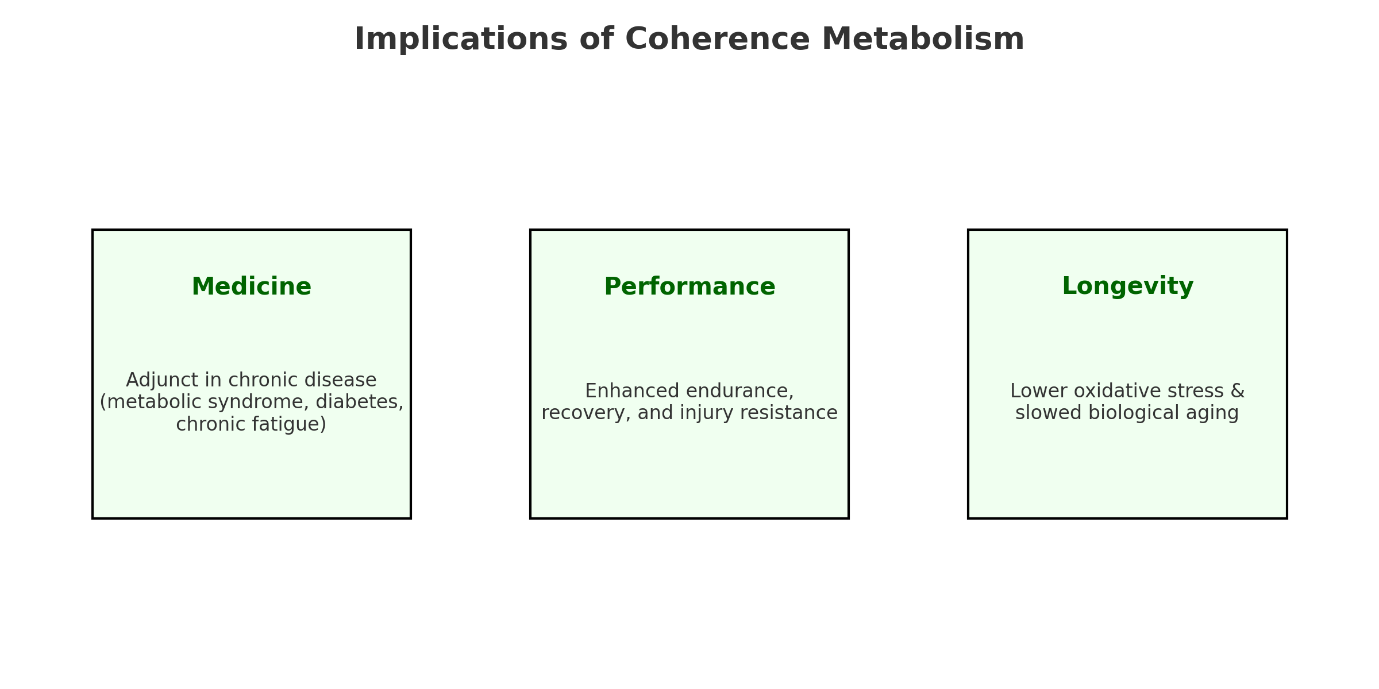
Coherence metabolism holds wide implications for medicine, performance, and longevity.
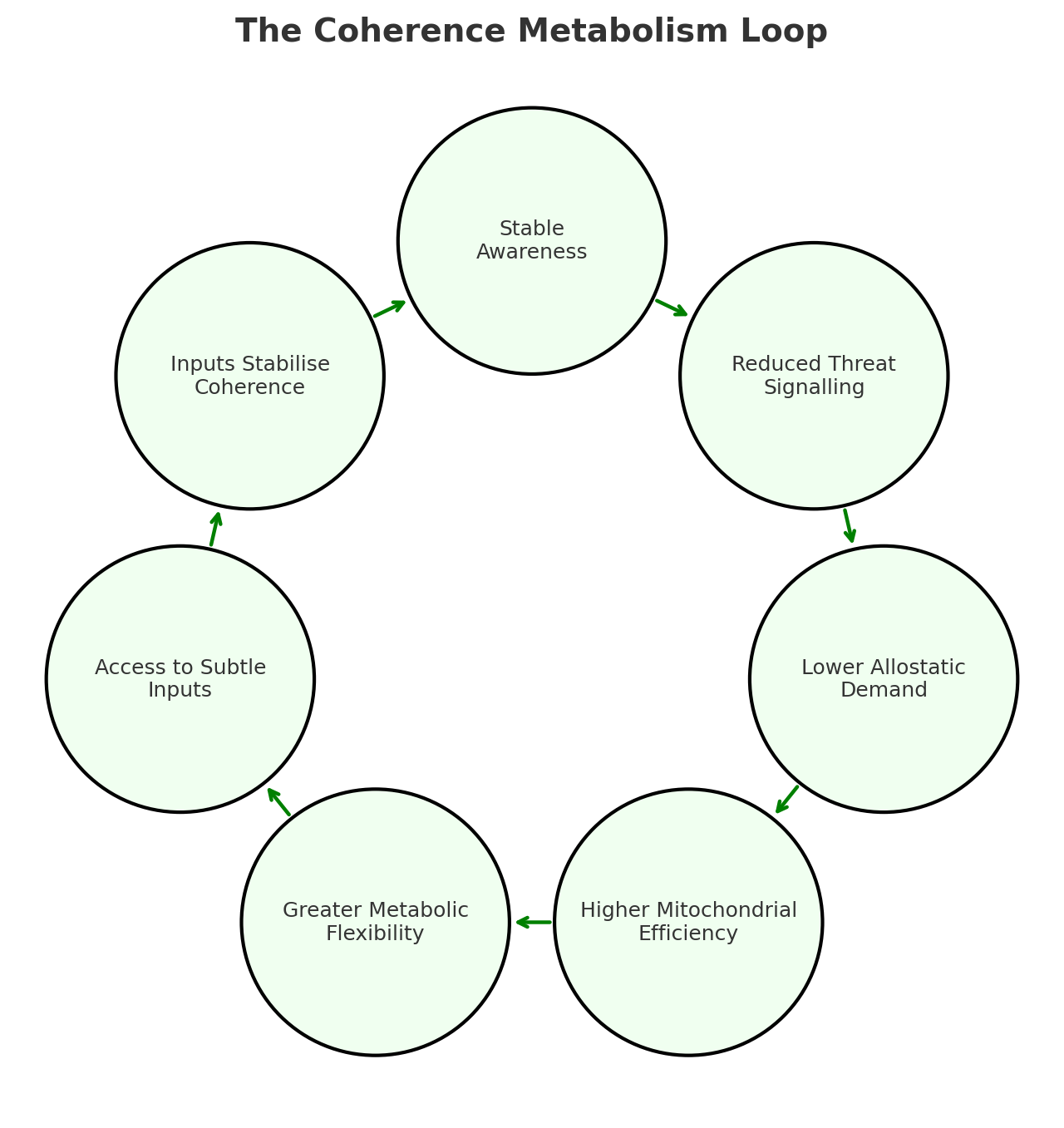
Summary: The Light Within the Body
Coherence is not a rare state to be chased, but a stable mode of being in which the body’s energy economy remembers its original design. In this state, the nervous system, endocrine rhythms, and cellular networks operate in harmony with the surrounding field, reducing biological cost and increasing efficiency.
Our findings suggest that stable awareness reorganises metabolism in measurable ways — lowering allostatic load, improving mitochondrial yield, and opening access to subtle energy inputs such as breath coherence, biophotonic exchange, and structured water charge. These mechanisms are not speculative ideals but observable shifts, seen both in field casework and supported by emerging physiological research.
When the organism no longer wastes resources on unnecessary prediction or defence, its relationship with energy changes. Scarcity gives way to sufficiency; reactive consumption gives way to regenerative flow. The body begins to draw not only from food and oxygen but from the quiet architecture of life itself — light, rhythm, and stillness — stored and transmitted through the fabric of form.
This is the metabolism of light:
a biology no longer trapped in survival loops,
a physiology aligned with its source tone,
a human system that remembers what it is to live in coherence with the field.